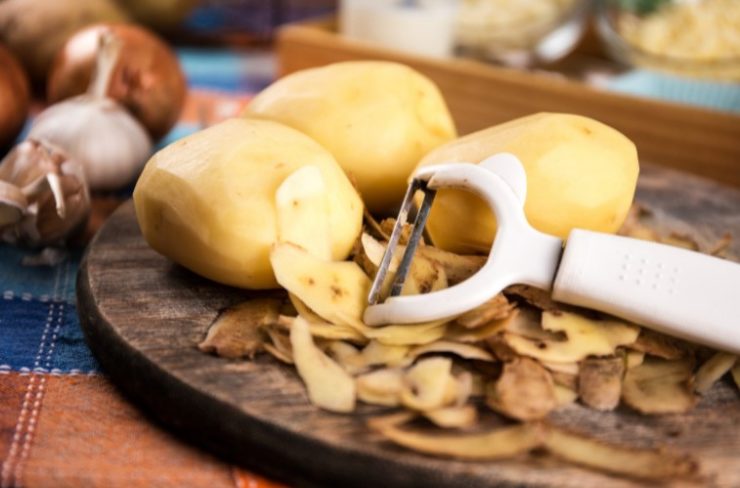Peeling potatoes can quickly become a frustrating chore in the kitchen, especially if you’re not sure of the correct way to do it. Nicked fingers, peels flying everywhere, and slippery potatoes popping out of your hand and rolling all over the house is not the best way to spend your time in the kitchen.
But with a few simple tips and tricks the process is simple and painless.
I’ll show you how to easily peel potatoes using a vegetable peeler, paring knife, or even your hands to make it faster and more efficient.
In This Article
A Few Tips Before You Get Peeling
Just like with most produce, your first step is to wash your potatoes. Run them under cool water and scrub with your hands or a brush to dislodge dirt and other particles.
Otherwise, small pieces of dirt and sand can get in the way and significantly dull your peeler. Plus, it’s always a good idea to wash away any potential bacteria or pesticide residue before you start cutting or peeling.
You may see others advise peeling potatoes right over the garbage can. But a half-peeled potato can be slippery, and too many times I’ve dropped the potato I was peeling right into the trash.
To combat this, take a plastic shopping bag and line a large bowl. Then I’ll peel the potatoes over the bowl. All the peels will be collected in the shopping bag, which you can tie up and toss in the trash when you’re finished for quick clean-up.
How To Peel A Potato With A Vegetable Peeler
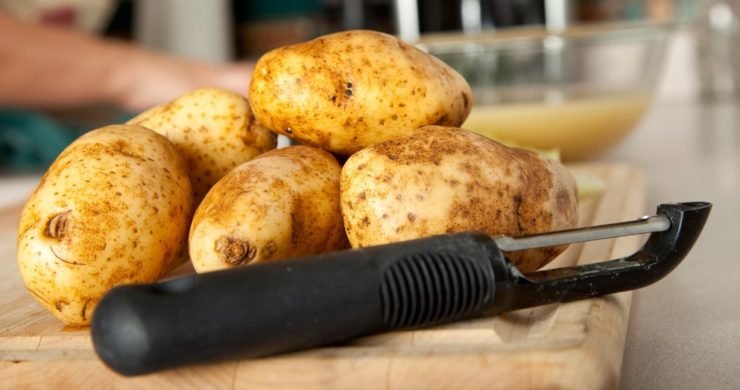
Begin by holding your potato in your non-dominant hand.
If you’re using a traditional peeler, you will grip it similar to a paint roller. For a y-peeler, wrap your third, fourth, and fifth fingers around the base, and hold the upper portion between your thumb and forefinger, like a pencil.
Begin at the top of the potato, and drag the peeler down toward your body, with moderate pressure.
You shouldn’t have to push or dig into the potato to get the peeler to remove the skin. If this is the case, the blade of your peeler is dull. You may want to invest in a new peeler or change the blades of the one you have.
Continue this motion, following the curve of the potato and removing strips of peel around the entire potato.
If you have an eye-remover on your peeler, you can use it to dig out any small eyes, stubborn sprouts, or imperfections on your potato.

Pro-Tip: I usually drop my peeled potatoes directly into a colander or pot of water, so I can easily rinse off excess starch and keep them from browning.
Let’s Talk Peelers: Traditional vs. Y

Traditional peelers feature a double blade parallel to the handle. It’s best for maneuvering curves and edges and is excellent for super irregularly shaped potatoes.
Y-peelers have a double blade perpendicular to the handle in the shape of a “Y.” These are best for peeling long, straight vegetables like carrots or relatively smooth potatoes.
No matter which peeler you choose, ensure the blade is sharp and, when possible, select straight blades over serrated ones.
Potato skin isn’t incredibly tough or thick (compared to a vegetable like a rutabaga). So, a serrated blade isn’t necessary and may take away too much of the potato you want to eat.
Both traditional peelers and Y-blade peelers are available to purchase with swivel blades. This means the blade isn’t stationary. Instead, it will swivel back and forth as you drag it down the vegetable, making bumpy and irregularly shaped potatoes a breeze to peel.
Consider a peeler that has a built-in eye-remover as well. This hollow, protruding bump on the side or top of your peeler will help remove unwanted eyes, sprouts, or imperfections from your potato.
How To Peel A Potato With A Paring Knife
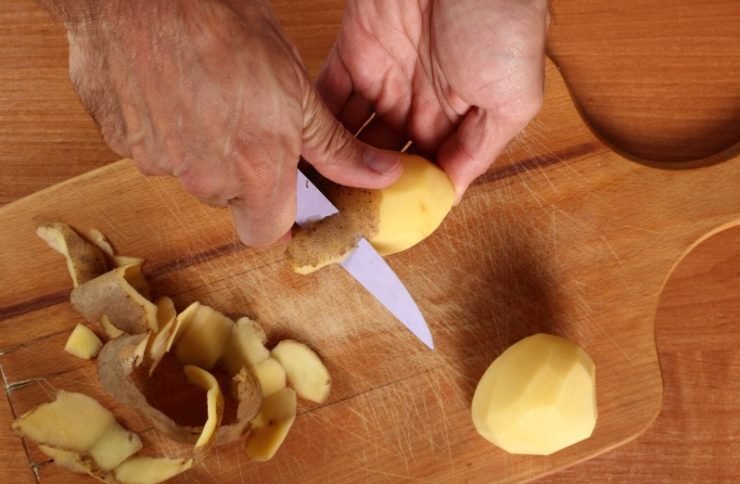
To use a knife for peeling a potato, you’ll want to use a sharp paring knife or a short-blade utility knife. The small blade makes it easy to maneuver the knife with one hand, and to follow the curve of the vegetable. That way you’re not losing massive amounts of delicious potato.
This method will certainly get the job done, but it’s almost always going to be slower and you’re likely to lose more potato flesh than with a peeler.
Start by holding a potato in your non-dominant hand.
With the paring knife in your dominant hand, place the blade at the top of the potato.
Then brace the hand with the knife against the potato by placing your thumb at the bottom. This will give you more control over your cut.
Using light pressure, pull the knife into the potato, just enough to slip under the peel.
Then, glide the blade toward your thumb, following the curve of the potato. Maintain enough pressure so the knife stays below the skin, but not so much that it dives deep into the meat of the potato.
Take it slow. You don’t want to slip and jab your thumb, so be mindful when peeling.
Continue rotating the potato, peeling away a strip of skin at a time until you’ve peeled the entire potato.
For any eyes, sprouts, or imperfections, use the tip of the knife to gently dig or pop them out.
How To Peel A Potato After Boiling
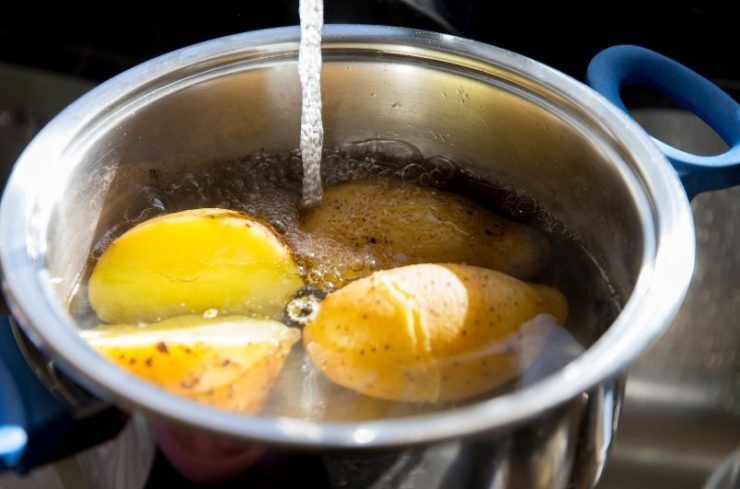
This method is best if you want to remove the thin skins from waxy potatoes, which hold their shape well when cooked. Starchy, all-purpose potatoes, on the other hand, can quickly become too mushy for this method to work effectively.
Small potatoes that can be cooked through in a short amount of time will work best here. For larger potatoes, you’ll want to cut them in half before beginning so they cook evenly and don’t take forever.
First, use a sharp paring knife to score each potato around its circumference. Don’t make this cut very deep. Instead, try to make it just passed the skin.
Place all the potatoes into a pot and cover with cold water and 1-2 tablespoons of salt.
Heat on high until the water comes to a boil, then lower the heat to a simmer.
Cover the pot with a lid, and gently boil for 20 minutes or until you can easily slide a fork into the largest potato.
Then, pour the potatoes into a colander in the sink and rinse with cold water so that they are easier to handle with your bare hands.
Take each potato and find the score mark. Starting here, you will be able to slip the peels right off.
Peeling Waxy vs. Starchy Potatoes
There are tons of varieties of potatoes, each with unique characteristics that may change how you prepare them. No matter the type, potato peels are edible, but some are more palatable than others.
Waxy potatoes are a variety of potatoes with very thin skin and low starch content. As a result, the skin is very tender and you don’t need to peel them before eating.
Waxy potatoes also hold their shape well when cooked, unlike starchy potatoes that fall apart and easily mash. So, for soups, stews, potato salads, and casseroles, opt for waxy potatoes, and leave their skin on.
New Potatoes, fingerling, Red Bliss, creamers, and Red Adirondack are all common varieties of waxy potatoes, but there are countless others out there.
If you’re not sure whether or not the potato you have is a waxy variety or not, try scratching it lightly with your fingernail. If the peel comes away easily, you’ve likely got a waxy potato.
Starchy varieties like Idaho and Russet, on the other hand, have tougher skin that is not always pleasant to eat. So I always advise peeling starchy potatoes unless you’re making baked potatoes or you want a really rustic mash.
Tips for Storing Potatoes
Unpeeled Potatoes
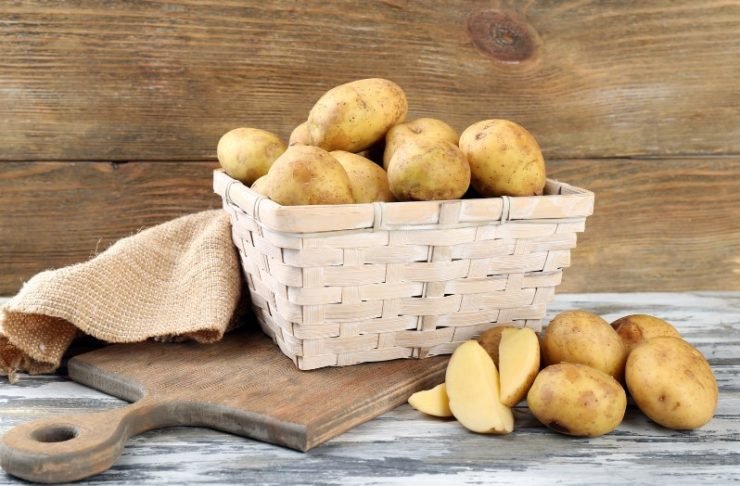
Keep unpeeled potatoes in a cool, dark place. Sunlight will cause them to sprout, so a dark cupboard is a perfect place to keep them.
Combat the urge to store your potatoes in the fridge. That kind of cold storage tricks the potatoes into thinking it’s Winter, and they need to start using their stored up starch for energy. The starches convert to sugar, negatively affecting the root’s taste and texture.
Peeled Potatoes
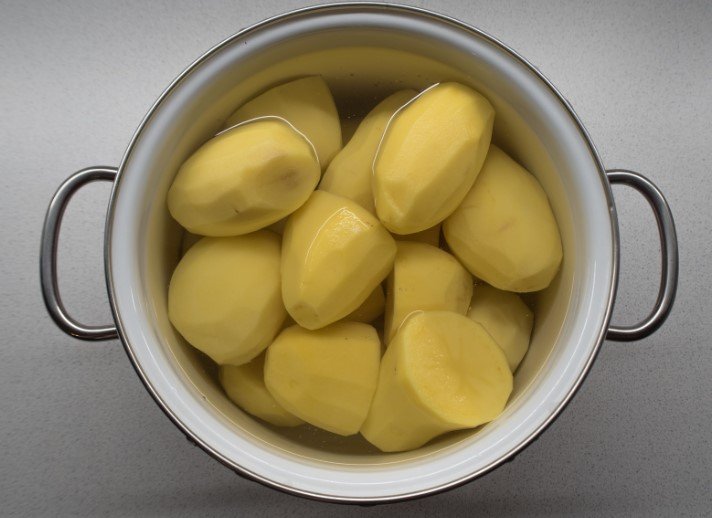
To store peeled potatoes, you must fully submerge them in water. Otherwise, they will brown and become unsightly.
Peeled potatoes, submerged in water, can be kept in the fridge for up to 24 hours. This is not a long-term storage solution though. As a rule of thumb, potatoes should be prepared and served on the same or next day.
Frequently Asked Questions
Is it easier to peel potatoes wet or dry?
It’s easier to peel dry potatoes since a wet potato can be more slippery. If you have time, wash your potatoes well before peeling so they can dry first.
How do you peel potatoes without a peeler?
If you don’t have a peeler, you can either use a paring knife to peel an uncooked potato or score the potato, then boil it, and the skin will slip right off.
What kind of peeler is best for potatoes?
A traditional peeler or y-peeler with a straight and sharp swivel blade is best for removing the skin from potatoes.

How To Peel A Potato
- Total Time: 1 minute
- Yield: 1 potato 1x
Description
Learn how to peel a potato with either a peeler or knife and how to peel a potato after boiling.
Ingredients
- 1 Clean Potato
Instructions
With a Peeler
- Hold the potato in your non-dominant hand.
- Starting at the top of the potato, drag the peeler downwards toward your body.
- Continue removing strips of peel around the entirety of the potato.
- Use the eyer to remove imperfections, or use the peeler repeatedly over dark spots.
With a Knife
- Hold the potato in your non-dominant hand.
- Brace your hand by placing the thumb of your dominant hand (the one holding the knife) at the bottom of the potato.
- Place the blade of the knife at the top of the potato; perpendicular to the potato.
- Wedge the blade underneath the skin and gently drag it downwards toward your thumb, taking care to follow the curve of the potato.
- Continue removing strips of peel around the entirety of the potato.
- Use the tip of the knife to create a divot to remove eyes, sprouts, dark spots, and other imperfections.
Peeling after Boiling
- Use a sharp paring knife to score each potato around its circumference.
- Place the scored potatoes into a pot.
- Cover with cold water, and add 1-2 tablespoons of salt.
- Heat on high until water comes to a boil, then lower heat.
- Cover the pot with a lid, and simmer for 20 minutes or until you can easily slide a fork into the largest potato.
- Pour potatoes into a colander and rinse with cold water.
- Take each potato and find the score mark.
- Use your fingers to slip the peels off.
- Prep Time: 1 minute
- Category: Knife Skills
- Cuisine: Any
Keywords: how to remove the skin from potatoes, peeling potatoes
